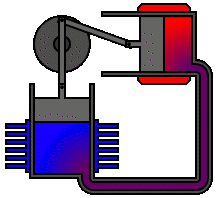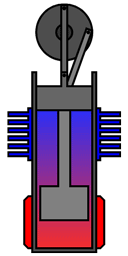|
Engineers classify Stirling engines into three distinct types. The Alpha type engine relies on interconnecting the power pistons of multiple cylinders to move the working gas, with the cylinders held at different temperatures. The Beta and Gamma type Stirling engines use a displacer piston to move the working gas back and forth between hot and cold heat exchangers in the same cylinder.
 Alpha Stirling Alpha Stirling
An alpha Stirling contains two separate power pistons in separate cylinders, one "hot" piston and one "cold" piston. The hot piston cylinder is situated inside the higher temperature heat exchanger and the cold piston cylinder is situated inside the low temperature heat exchanger.
This type of engine has a very high power-to-volume ratio but has technical problems due to the usually high temperature of the "hot" piston and the durability of its seals.
B eta Stirling eta Stirling
A beta Stirling has a single power piston arranged within the same cylinder on the same shaft as a displacer piston.
The displacer piston is a loose fit and does not extract any power from the expanding gas but only serves to shuttle the working gas from the hot heat exchanger to the cold heat exchanger. When the working gas is pushed to the hot end of the cylinder it expands and pushes the power piston.
When it is pushed to the cold end of the cylinder it contracts and the momentum of the machine, usually enhanced by a flywheel, pushes the power piston the other way to compress the gas. Unlike the alpha type, the beta type avoids the technical problems of hot moving seals.
Gamma Stirling
A gamma Stirling is simply a beta Stirling in which the power piston is mounted in a separate cylinder alongside the displacer piston cylinder, but is still connected to the same flywheel. The gas in the two cylinders can flow freely between them and remains a single body. This configuration produces a lower compression ratio but is mechanically simpler and often used in multi-cylinder Stirling engines.
Other Types
Changes to the configuration of mechanical Stirling engines continue to interest engineers and inventors. Notably, some are in pursuit of the rotary Stirling engine; the goal here is to convert power from the Stirling cycle directly into torque, a similar goal to that which led to the design of the rotary combustion engine. No practical engine has yet been built but a number of concepts, models and patents have been produced.
There is also a field of "free piston" Stirling cycles engines, including those with liquid pistons and those with diaphragms as pistons.
An alternative to the mechanical Stirling engine is the fluidyne pump, which uses the Stirling cycle via a hydraulic piston. In its most basic form it contains a working gas, a liquid and two non-return valves. The work produced by the fluidyne goes into pumping the liquid.
A recent development of Stirling engines are the thermoacoustic stirling engine, which looks like the beta Stirling engines but without the displacer.
|
 Alpha Stirling
Alpha Stirling eta Stirling
eta Stirling